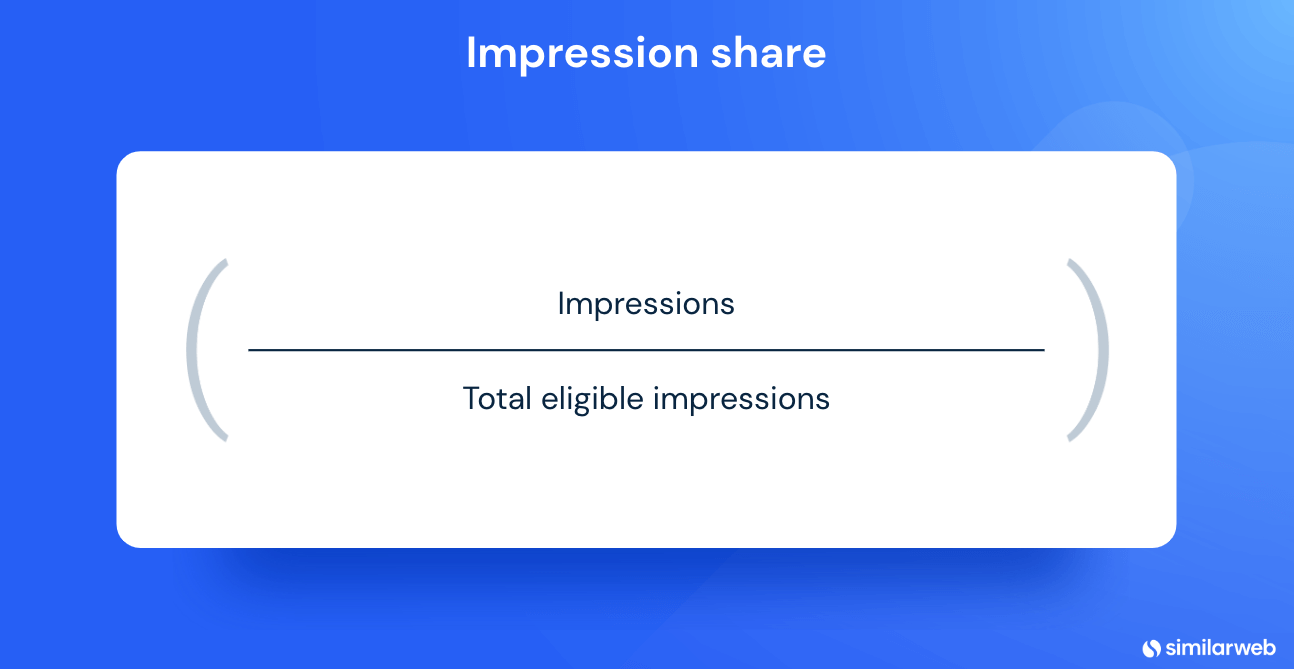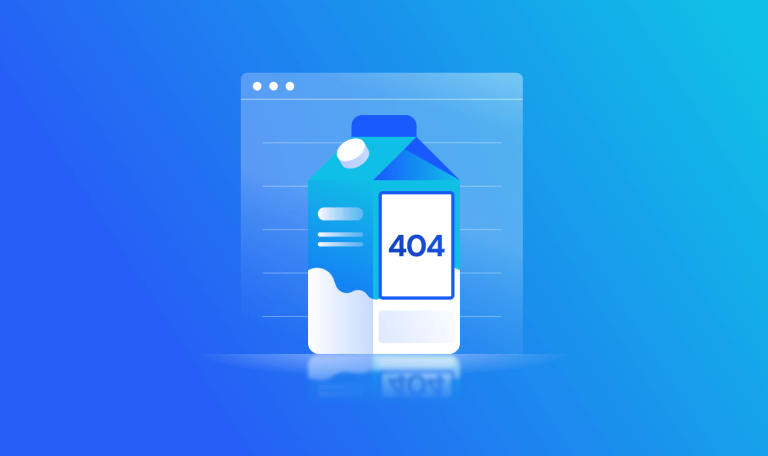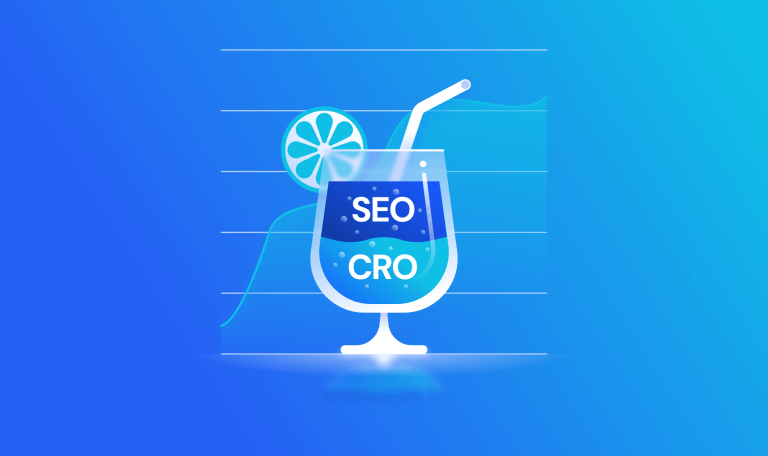7 Proven Ways To Increase Your Impression Share in Google Ads

Can your ads drive sales if nobody sees them? Of course not.
This is why ad impressions (that is, the number of times people see your ad) are among the most prominent advertising KPIs that marketers use to analyze ad performance.
If your ad has thousands of impressions but very few clicks, something might be wrong with your ad copy. But if your ad isn’t getting many impressions to begin with, you need to find out why Google isn’t showing it to your audience and how you can fix it.
This is where impression share comes in. So, what is impression share?
Impression share (IS) is a percentage score representing the number of impressions your ad gets out of the total number of impressions it was eligible to get. Eligibility is based on your ad’s targeting, bid, approval settings, and quality. In general, the higher the impression rate, the better.
Here’s how to calculate impression share:
How about an example? An impression share of 60% means Google isn’t showing your ad to 40% of the users you can potentially reach. That means those users are seeing ads from your competitors instead.
Impression share provides insight into your ad performance and helps you understand if your ad is reaching your target audience the way you want and if it has potential. It is not a specific key performance metric, so the goal is to know you have traction, not to reach 100%.
So, how do you increase the impression share of your Google ads? Here are some of the best ways to do just that.
How to increase impression share
To improve your impression rate, you first need to understand what’s limiting your impressions – and why. Then, after you’ve diagnosed the problem, you can use one of (or a few of) the following methods to increase your impression rate.
1. Analyze your competitors
What is it?
Thousands of brands use Google ads in every industry. By analyzing your competitors’ ads, you can find what’s working for them, steal some inspiration, and adjust your ads to increase your impression share.
Why does it work?
Ad quality is one of the critical factors in determining an ad’s impression share. A PPC Competitor analysis allows you to learn from the highest quality ads and use their proven formula to increase your ad quality rating. The higher your quality score, the more impressions you could get.
How can you replicate it?
You can manually search Google for your target keywords and analyze your competitors’ ad funnel. Or you can make your life a bit easier, and your data more accurate, by using Similarweb’s Digital Marketing Intelligence tool, which shows you:
- Best-performing competitor ads
- Their target keywords
- Their target audience
- Their ad creatives
- Their ad budgets
These priceless insights can help you figure out what to optimize and how to tailor your Google ads for optimal performance.
2. Improve your ad quality
What is it?
Ad quality is a metric Google uses to estimate an ad’s user experience. It considers your ad’s relevance to your target keywords, the likelihood of users clicking it, and your landing page’s alignment with your ad and user intent (along with several other factors). Your ad quality directly impacts your ad’s impression share.
Why does it work?
Google wants to show the most relevant ads to searchers. To achieve this goal, it uses ad quality as the primary factor when evaluating ads. So, if two ads compete for the same spot, Google Ads would go for the one with the higher ad quality score. In fact, Google might not show low-quality ads at all, or display them in less prominent spots.
How can you replicate it?
You can improve your ad quality by:
- Using relevant keywords in your ad copy
- Optimizing your ad title and copy for clicks
- Improving your ad targeting
- Ensuring that your ad’s landing page is consistent with its core message.
3. Optimize for relevant keywords
What is it?
Keywords are the backbone of any advertising strategy and Google is no exception. You can use the following keyword types when optimizing your Google ads.
Broad match: Google displays your ads to a wide range of keyword searches directly or indirectly related to your main keywords.
Phrase match: Google displays your ads against search phrases that mean the same thing as your target keywords.
Exact match: Google displays your ads against searches that exactly match your keywords.
Why does it work?
Broad match and phrase match keywords help your ad get the widest reach. But, they’re low on accuracy. Exact match keywords have high accuracy meaning Google shows them only to the most relevant searchers. But they give you fewer impressions.
How can you replicate it?
To improve your impression share and still get relevant traffic, use a combination of broad match and exact match searches.
Pro tip: Use Similarweb’s Marketing Intelligence to find the keywords your top competitors use to improve your own ad’s accuracy.
4. Improve your audience targeting
What is it?
Google Ads provides multiple audience targeting filters like demographics, location, interests, and gender (to name a few), to ensure your ad is shown to the most relevant users. Improving your audience targeting to hone in on your potential customers might be all you need to do.
Why does it work?
Irrelevant targeting or targeting that’s too broad often results in lower impressions as it decreases your ad quality. But too many filters can also decrease your impressions. So, find the middle ground and really think about your targeting here.
How can you replicate it?
Apply the geo-targeting filter to limit your ads to your target regions. Plus, target your audience’s interests to improve ad relevance. Be careful with other filters like gender and age though, because tightening them too much can reduce your impressions.
5. Filter negative keywords
What is it?
You can use negative keywords to tell Google not to show your ads for specific search queries.
Why does it work?
Applying the negative keywords filter saves your ad from irrelevant impressions and clicks, and helps Google narrow down your target audience. This improves your overall impression share as it increases your ad’s quality score. 📈
How can you replicate it?
Identify the keywords or terms you don’t want Google to target when displaying your ads and enter them in the negative keywords filter when setting up your ad. Continue optimizing and improving your list as you go along.
6. Increase your budget
What is it?
Your ad budget is the amount you’re prepared to spend on a Google Ad campaign.
Why does it work?
When you have a low campaign budget Google automatically lowers your ad frequency to equally distribute your ads across your selected campaign duration. So, increasing your budget naturally increases your impressions as well.
How can you replicate it?
When you have a perfectly optimized ad targeting the right audience and keywords, the likely reason for a low impression share is your limited budget. Once you increase your campaign budget, Google starts displaying your ad to your audience.
7. Increase your keyword bid
What is it?
In Google Ads, your keyword bid is the amount of money you’re willing to pay per click on your ad for a specific keyword. Sometimes your bid is too low and if you increase it, you can get more impressions, clicks, and conversions.
Why does it work?
Google Ads uses an auction model where different advertisers bid for the same keywords to display their ads. All things equal, Google displays the ad from the highest bidder. It uses the cost-per-click (CPC) pricing model where you’re charged every time a user clicks on your ad.
By increasing your bid for a specific keyword, you can increase your chances of displaying your ad. Keyword bid is different from your budget. Your campaign budget is the overall expense of your campaign, including multiple keyword bids.
Example image of keyword bid vs campaign budget
How can you replicate it?
Increasing your keyword bid effectively means increasing your CPC. When you increase your CPC, you automatically win more auctions and your impression share increases. However, you must ensure that your campaign remains profitable despite increasing your CPC. This strategy works fine for short campaigns where you’re looking to achieve a specific goal quickly. But it’s hard to sustain over a longer period because it’s hard to maintain your profitability.
Keep testing to increase your Google Ads impression share
As we’ve pointed out, there can be a number of ways to increase your Google Ads impression share. However, there’s no guaranteed fix because there are so many variables involved. The best path to improving your impression share is to carefully diagnose the problem and then test different solutions to see what works. Warning: patience may be required.
In addition, keep testing different ad formats, copy versions, landing pages, and keywords to find the optimal campaign for your business goals.
Impression Share FAQs
How do you improve impression share?
Google recommends understanding the reasons for low impression share, improving your ad quality and targeting, increasing your budget, and choosing more accurate keywords as possible ways to improve your impression share in Google Ads.
Can you get a 100% impression share?
Yes, it is possible to get a 100% impression share. But that rarely happens, especially in competitive niches.
What affects impression share?
Your ad quality, keyword and geo-targeting, budget and bid, and competition are the main factors that impact your impression share.
What is a good impression share percentage?
This varies across industries, but anything 65-70% in a competitive industry is good.
The #1 PPC tool - get started
Give it a try or talk to our marketing team — don’t worry, it’s free!









